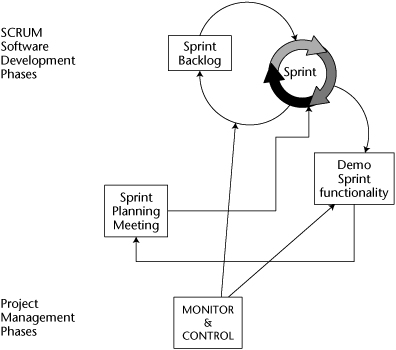The Monitoring and Controlling Phase of an Iterative SDPM Strategy for the SCRUM Model
Figure 21-6 illustrates the Monitoring and Controlling Phase of an Iterative SDPM strategy for the SCRUM model.
Figure 21-6. The Monitoring Phase of an Iterative SDPM strategy for the SCRUM model

The focus of monitoring and control here is the status of the Sprint Backlog. When created, the Sprint Backlog contains the features that the team had planned to build and integrate in 30 days. The nature of a SCRUM is to have the team of subject matter experts (SME) focus on development and not be hampered with a lot of non-value-added work—such as formal reporting. In addition to the features metrics introduce earlier in this chapter, one additional, simple metric is of value to those who simply must have some measure of progress. In the Sprint Planning Meeting, the team should have provided individual estimates of the duration (or labor) needed for each feature in the coming Sprint. Compare that to the actual duration (or labor) expended. The ratio of cumulative actual to cumulative estimated gives some measure of efficiency. Additionally, the percentage of the Sprint Backlog completed (as measured by the hours of duration) compared to the percentage of working hours expended gives some measure of the status of the Sprint Backlog. If that metric is too cumbersome to be useful, you might simply take ...
Get Effective Software Project Management now with the O’Reilly learning platform.
O’Reilly members experience books, live events, courses curated by job role, and more from O’Reilly and nearly 200 top publishers.

